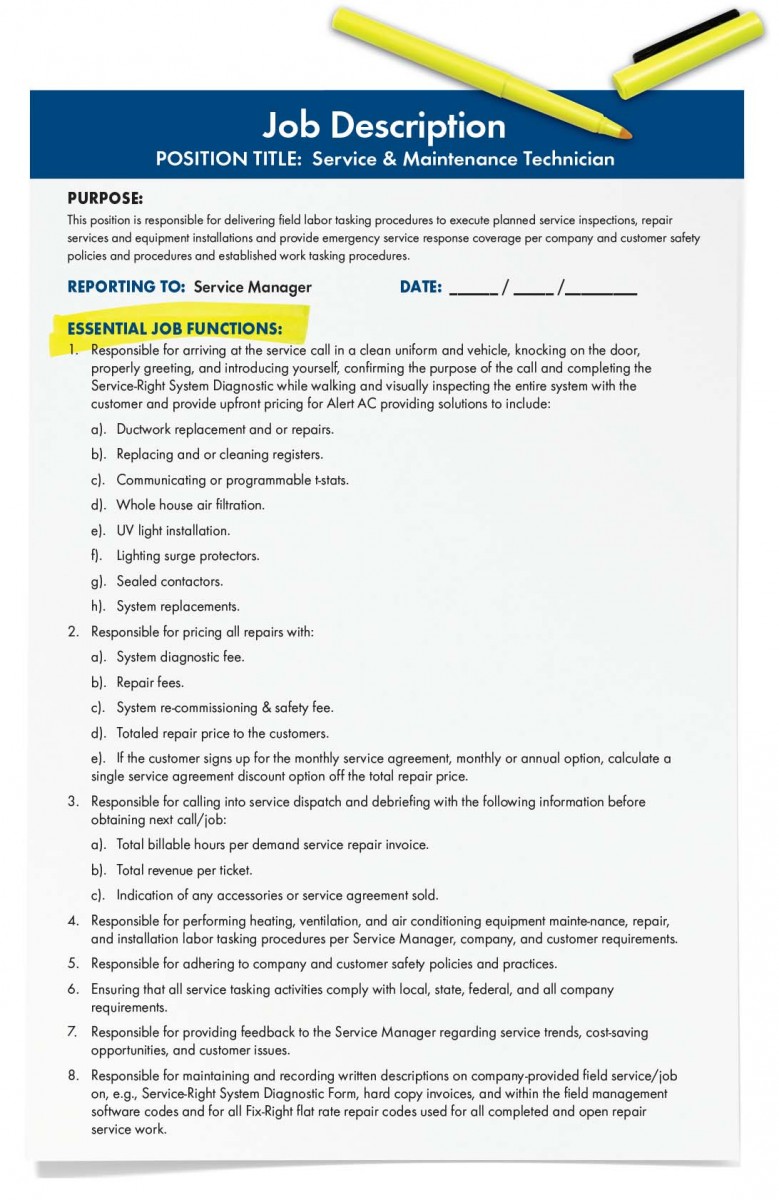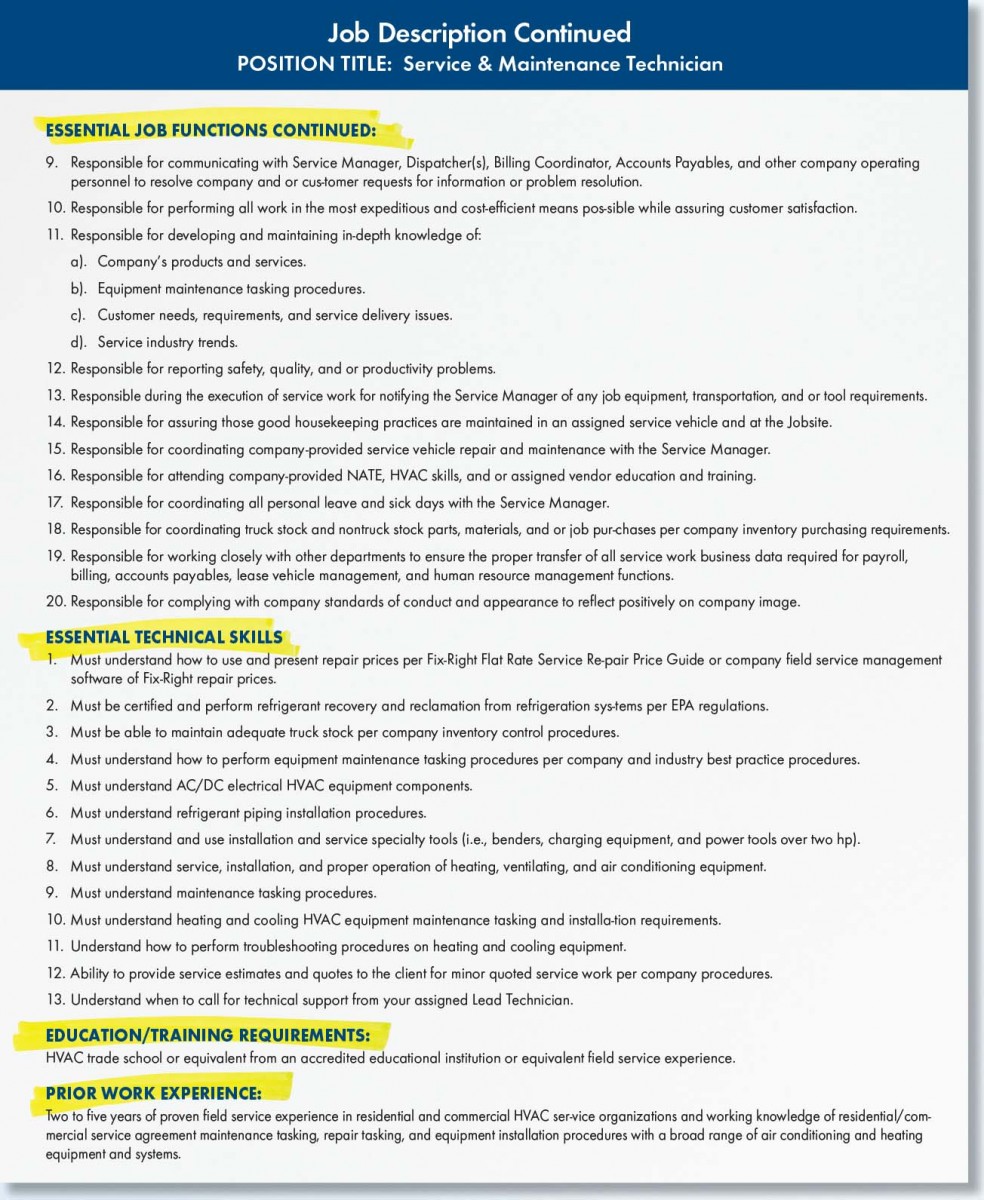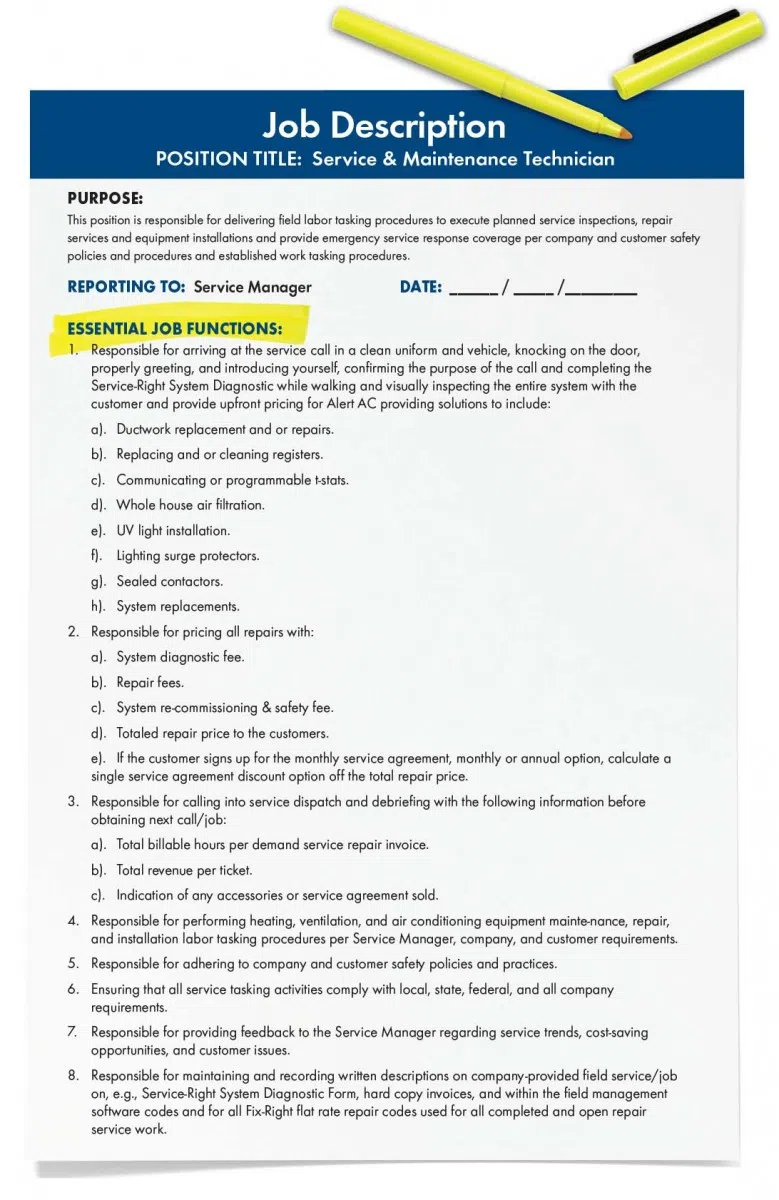Writing an employee job description is a crucial step every residential HVAC contractor should take for all positions within the company. Job descriptions enable managers to create better job postings, set employment expectations, and become the basis for future on-the-job performance management. Benefits of a written job description? It helps you in the hiring process by providing employees with your expectations as well as assisting with evaluating future performance.
In most cases, a job description – unlike a contract of employment – is not a legally binding document. You can still ask employees to take on other reasonable duties at any time. However, do they act as informal contracts between each employee and the company, specifying the services the employee will provide in consideration of the company’s wages and incentives to the employee?
These are the typical HVAC job descriptions by title:
- Owner/General Manager
- Human Resource Manager/Comptroller
- Dispatcher/Customer Care Manager
- Residential Service Manager
- Residential Installation Manager
- Residential Replacement Comfort Advisor
- Residential Sales Manager
- Service & Maintenance Technician
- Residential Equipment Replacement Installer
- Office Manager
- Receptionist
- Truck Driver/Warehouse Supervisor
- Bookkeeper
Having a detailed job description assists the hiring effort by knowing what knowledge, skills, abilities, and duties you require for a specific position. Job description information focuses the hiring manager on what they should be looking for in a candidate.
What should the job description sections include?
- Tied to company work delivery standards & company culture.
- Position Title - This section describes the working title which is used.
- Example: Position Title: Service & Maintenance Technician.
- Purpose - This section describes the scope and level of responsibility of a type of job within the company in brief and concise statements.
- Reporting to - This section describes in brief to whom the job applicant will report. Example: Reporting to the Service Manager.
- Essential job functions - This section describes a summary of a position’s general duties and responsibilities and includes a statement showing the relationship of the job’s fit to the Company’s mission.
- Essential Technical Skills - This section summarizes the general technical skills necessary to do the job.
- Education/Training Requirements - This section describes the minimum educational and training requirements necessary to perform in a position.
- Prior Work Experience - This section describes the previous work experience that would lead to subsequent success in the position.
- Performance expectations – Use this section for ongoing objective performance evaluations of the job.
- Behavior factors with customers, company, and fellow employees.
Without a good job description, you run the risk of conflicting expectations between management and employee. Why? Because it is exceedingly difficult for an employee to know what is expected of them or for their manager to provide an accurate, fair, and effective performance appraisal. Without a job description, many managers are more likely to assess employees based on personal likes and dislikes than defined performance criteria.
Service & Maintenance Technician Job Description
Employee and supervisor signatures are an essential part of mutually ratifying the job description. The employee’s signature shows that the job description has been agreed upon and understands the position’s requirements, functions, duties, and how to behave with customers, the company, and fellow employees.
Conduction Performance Evaluations:
“How am I doing?” Nearly all employees want an answer to this question.
Employee performance reviews answer the “how am I doing?” question for each employee continuously.
- Feedback to employees helps improve their performance, decreases turnover, motivates self-improvement, builds trust, and creates a paper trail useful in litigation. You do this at every opportunity to say that they have done a good job.
Areas Where You Should Provide In Passing Positive Feedback:
- When your work delivery processes or forms are talked about.
- When giving employees more tasks.
- When you provide constructive criticism.
- When you praise them.
- When they give you good feedback.
- When you wish to maintain positive energy.
Having a written job description contract between employee and company makes it possible to discuss performance situations to:
- Help employees improve their performance.
- Help employees with their career planning.
- Take advantage of employee insights for improving the business.
- Identify training and retraining needs.
- Encourage and motivate employees.
Job Description
POSITION TITLE: Service & Maintenance Technician
PURPOSE:
This position is responsible for delivering field labor tasking procedures to execute planned service inspections, repair services and equipment installations and provide emergency service response coverage per company and customer safety policies and procedures and established work tasking procedures.
REPORTING TO: Service Manager DATE: ______ / _____ /_________
ESSENTIAL JOB FUNCTIONS:
1. Responsible for arriving at the service call in a clean uniform and vehicle, knocking on the door, properly greeting, and introducing yourself, confirming the purpose of the call and completing the Service-Right System Diagnostic while walking and visually inspecting the entire system with the customer and provide upfront pricing for Alert AC providing solutions to include:
a). Ductwork replacement and or repairs.
b). Replacing and or cleaning registers.
c). Communicating or programmable t-stats.
d). Whole house air filtration.
e). UV light installation.
f). Lighting surge protectors.
g). Sealed contactors.
h). System replacements.
2. Responsible for pricing all repairs with:
a). System diagnostic fee.
b). Repair fees.
c). System re-commissioning & safety fee.
d). Totaled repair price to the customers.
e). If the customer signs up for the monthly service agreement, monthly or annual option, calculate a single service agreement discount option off the total repair price.
3. Responsible for calling into service dispatch and debriefing with the following information before obtaining next call/job:
a). Total billable hours per demand service repair invoice.
b). Total revenue per ticket.
c). Indication of any accessories or service agreement sold.
4. Responsible for performing heating, ventilation, and air conditioning equipment mainte-nance, repair, and installation labor tasking procedures per Service Manager, company, and customer requirements.
5. Responsible for adhering to company and customer safety policies and practices.
6. Ensuring that all service tasking activities comply with local, state, federal, and all company requirements.
7. Responsible for providing feedback to the Service Manager regarding service trends, cost-saving opportunities, and customer issues.
8. Responsible for maintaining and recording written descriptions on company-provided field service/job on, e.g., Service-Right System Diagnostic Form, hard copy invoices, and within the field management software codes and for all Fix-Right flat rate repair codes used for all completed and open repair service work.
9. Responsible for communicating with Service Manager, Dispatcher(s), Billing Coordinator, Accounts Payables, and other company operating personnel to resolve company and or cus-tomer requests for information or problem resolution.
10. Responsible for performing all work in the most expeditious and cost-efficient means pos-sible while assuring customer satisfaction.
11. Responsible for developing and maintaining in-depth knowledge of:
a). Company’s products and services.
b). Equipment maintenance tasking procedures.
c). Customer needs, requirements, and service delivery issues.
d). Service industry trends.
12. Responsible for reporting safety, quality, and or productivity problems.
13. Responsible during the execution of service work for notifying the Service Manager of any job equipment, transportation, and or tool requirements.
14. Responsible for assuring those good housekeeping practices are maintained in an assigned service vehicle and at the Jobsite.
15. Responsible for coordinating company-provided service vehicle repair and maintenance with the Service Manager.
16. Responsible for attending company-provided NATE, HVAC skills, and or assigned vendor education and training.
17. Responsible for coordinating all personal leave and sick days with the Service Manager.
18. Responsible for coordinating truck stock and nontruck stock parts, materials, and or job pur-chases per company inventory purchasing requirements.
19. Responsible for working closely with other departments to ensure the proper transfer of all service work business data required for payroll, billing, accounts payables, lease vehicle management, and human resource management functions.
20. Responsible for complying with company standards of conduct and appearance to reflect positively on company image.
ESSENTIAL TECHNICAL SKILLS
- Must understand how to use and present repair prices per Fix-Right Flat Rate Service Re-pair Price Guide or company field service management software of Fix-Right repair prices.
- Must be certified and perform refrigerant recovery and reclamation from refrigeration sys-tems per EPA regulations.
- Must be able to maintain adequate truck stock per company inventory control procedures.
- Must understand how to perform equipment maintenance tasking procedures per company and industry best practice procedures.
- Must understand AC/DC electrical HVAC equipment components.
- Must understand refrigerant piping installation procedures.
- Must understand and use installation and service specialty tools (i.e., benders, charging equipment, and power tools over two hp).
- Must understand service, installation, and proper operation of heating, ventilating, and air conditioning equipment.
- Must understand maintenance tasking procedures.
- Must understand heating and cooling HVAC equipment maintenance tasking and installa-tion requirements.
- Understand how to perform troubleshooting procedures on heating and cooling equipment.
- Ability to provide service estimates and quotes to the client for minor quoted service work per company procedures.
- Understand when to call for technical support from your assigned Lead Technician.
EDUCATION/TRAINING REQUIREMENTS:
HVAC trade school or equivalent from an accredited educational institution or equivalent field service experience.
PRIOR WORK EXPERIENCE:
Two to five years of proven field service experience in residential and commercial HVAC ser-vice organizations and working knowledge of residential/commercial service agreement maintenance tasking, repair tasking, and equipment installation procedures with a broad range of air conditioning and heating equipment and systems.
PERFORMANCE FACTORS:
Incumbent must have:
- Ability to work 40 hours per week, scheduled in 8- to 10-hour shifts.
- Ability to work 10 to 20 hours overtime per week.
- Ability to work in indoor and outdoor environments, including hot, wet, cold, and or windy conditions caused by weather.
- Ability to physically turn 180 degrees and walk 2-4 hours per day.
- Ability to stand or climb 4 to 6 hours per day.
- Ability to climb up and down a 30-foot ladder.
- Ability to work in hot or confined spaces.
- Ability to kneel, lift, reach above shoulders, and bend 4 to 5 hours per day.
- Ability to squat and sit 1 to2 hours per day.
- Ability to lift weights of 1 to 50 pounds in various shapes and sizes from concrete blocks to refrigerant cylinders to 20-foot lengths of pipe.
- The physical ability to use both hands continuously for grasping, frequently for fine manipu-lation, and occasionally for fingering.
- The physical ability to frequently push/pull various items, tools, and equipment weighing up to 80 pounds distances between 10 inches and 15 feet.
- The physical ability to frequently operate different types of equipment including, but not limited to, industrial flatbed trucks and other power or manually operated tools and equipment necessary for installations.
- The physical ability to tolerate required personal protective equipment such as hard hats, safety glasses, ear protection, and safety shoes continuously.
- Ability to lift a weight from the floor to shoulder height.
- Understands and works effectively with critical internal group dynamics to get the job done.
- Actively explores with others the advantages and disadvantages of a course of action.
- Ensures that various internal groups work together toward a common business approach.
- Efficiently manages multiple tasks (e.g., selects and applies proper tools).
- Systematically gathers and analyzes pertinent information to plan the most effective course of action.
- Anticipates potential problems and develops contingency plans to avoid them.
- The ability to evaluate problems and issues and to make proper decisions.
- Effective use of time management.
OTHER MINIMUM REQUIREMENTS:
- Must meet company vehicle insurance requirements.
- Ability to travel to customer job sites.
- Ability to work whatever hours or times to meet specific organizational needs.
- Have excellent communication and written skills.
While it might seem simplistic, it pays to ensure that your employees read the job description and evaluation process. Yes, they might sign on the dotted line, but that doesn’t mean they actually read or understand it. Ask your employees if they have any questions, and if you add any new duties to the list, be sure to inform them. Taking this simple precaution will be a safety valve if a disagreement arises.
Wendell Bedell is CEO of GrowMyHVAC.com and President of HVACPro podcast companies. For detailed information about GrowMyHVAC.com’s or HVACPro podcast’s many high impact HVAC Business Operating Manual’s based best-of-the-best practices as well as, upfront price guides to help you “harvest” more on each call, simply call 800.240.2823 or visit them at
www.GrowMyHVAC.com.











